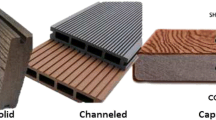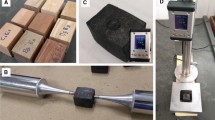Abstract
The influence of viscoelastic thermal compression (VTC) on surface wettability and bonding performance of wood was evaluated. Low quality beech (Fagus sylvatica L.) and Norway spruce (Picea abies (L.) Karst.) were densified with the VTC process to different degrees of densification. Control and densified strips were bonded with phenol–formaldehyde (PF) adhesive and liquefied wood (LW). Shear strength of bonded assemblies was determined after 1 week of conditioning at 20 °C and relative humidity of 65 %. Wettability was determined on the basis of the contact angle of water, PF adhesive, and LW using the Wilhelmy method. Results showed that densification of beech and spruce wood did not significantly affect the shear strength of specimens bonded with PF adhesive. In beech assemblies bonded with LW shear strength decreased significantly with increased density, whereas in bonded spruce specimens decrease of shear strength was not significant. It was found that degree of densification and bonding process used in the study were not appropriately chosen for spruce wood specimens, since major deformations after the bonding process occurred. Wettability changed significantly after densification. Contact angle of water and LW increased after densification, whereas contact angle of PF showed inverse trend and decreased after VTC process. Furthermore, the degree of densification had a minor effect on the wettability.
Zusammenfassung
Der Einfluss einer viskoelastischen thermischen Verdichtung (VTC) auf die Oberflächenbenetzbarkeit und das Verklebungsverhalten wurde untersucht. Buchen- (Fagus sylvatica L.) und Fichtenholz (Picea abies (L.) Karst.) geringer Qualität wurden mit viskoelastischer thermischer Verdichtung verschieden stark verdichtet. Kontroll- und verdichtete Proben wurden mit Phenol-Formaldehyd-(PF)-Harz und Flüssigholz (LW) verklebt. Die Scherfestigkeit der verklebten Prüfkörper wurde nach einwöchiger Konditionierung bei 20 °C und 65 % relativer Feuchte bestimmt. Die Benetzbarkeit wurde anhand des Kontaktwinkels von Wasser, PF-Harz und Flüssigholz mit Hilfe der Wilhelmy-Methode bestimmt. Die Ergebnisse zeigten, dass die Verdichtung von Buchen- und Fichtenholz keinen signifikanten Einfluss auf die Scherfestigkeit der mit PF-Harz verklebten Prüfkörper hatte. Bei den mit Flüssigholz verklebten Buchenprüfkörpern nahm die Scherfestigkeit mit zunehmender Dichte signifikant ab, wohingegen der Rückgang der Scherfestigkeit in verklebten Fichtenprüfkörpern nicht signifikant war. Es zeigte sich, dass die in dieser Studie verwendeten Verdichtungsgrade und Verklebungsverfahren für die Prüfkörper aus Fichtenholz nicht geeignet sind, da nach dem Verkleben starke Verformungen auftraten. Die Benetzbarkeit war nach der Verdichtung signifikant verändert. Der Kontaktwinkel von Wasser und Flüssigholz nahm nach der Verdichtung zu, wohingegen der Kontaktwinkel von PF-Harz einen gegenteiligen Trend aufwies und nach der VTC-Behandlung abnahm. Darüber hinaus hatte der Verdichtungsgrad einen geringen Einfluss auf die Benetzbarkeit.



Similar content being viewed by others
References
Antonovic A, Jambrekovic V, Kljak J, Spanic N, Medved S (2010) Influence of urea-formaldehyde resin modification with liquefied wood on particleboard properties. Drv Ind 61(1):5–14
Blomberg J, Persson B (2004) Plastic deformation in small clear pieces of Scots pine (Pinus sylvestris) during densification with the CaLignum process. J Wood Sci 50(4):307–314
Christiansen AW (2005) Chemical and mechanical aspects of HMR primer in relationship to wood bonding. Forest Prod J 55(11):73–78
EN 12765 (2001) Classification of thermosetting wood adhesives for non-structural applications. CEN-European Committee for Standardization, Brussels
EN 205 (2003) Adhesives, Wood adhesives for non-structural applications. Determination of tensile shear strength of lap joints. CEN-European Committee for Standardization, Brussels
Frihart CR (2005) Adhesive bonding and performance testing of bonded wood products. J ASTM Int 2(7):1–12
Frihart CR (2006) Wood structure and adhesive bond strength. In: Stokke D, Groom LH (eds) Characterization of the cellulosic cell wall. Blackwell Publishing Ltd. Oxford, pp 241–253
Gabrielli C, Kamke FA (2008) Treatment of chemically modified wood with VTC process to improve dimensional stability. For Prod J 58(12):82–86
Gabrielli CP, Kamke FA (2010) Phenol-formaldehyde impregnation of densified wood for improved dimensional stability. Wood Sci Technol 44(1):95–104
Gerardin P, Petric M, Petrissans M, Lambert J, Ehrhrardt JJ (2007) Evolution of wood surface free energy after heat treatment. Polym Degrad Stabil 92(4):653–657
Gindl M, Reiterer A, Sinn G, Stanzl-Tschegg SE (2004) Effects of surface ageing on wettability, surface chemistry, and adhesion of wood. Holz Roh Werkst 62:273–280
Jennings JD, Zink-Sharp A, Kamke FA, Frazier CE (2005) Properties of compression densified wood. Part 1: bond performance. J Adhes Sci Technol 19(13–14):1249–1261
Jennings JD, Zink-Sharp A, Frazier CE, Kamke FA (2006) Properties of compression-densified wood, Part II: surface energy. J Adhes Sci Technol 20(4):335–344
Kamke FA (2006) Densified radiata pine for structural composites. Maderas Ciencia y tecnología 8(2):83–92
Kamke FA, Sizemore H (2008) Viscoelastic thermal compression of wood. US Patent No. 7.404.422
Kunaver M, Medved S, Cuk N, Jasiukaityte E, Poljansek I, Strnad T (2010) Application of liquefied wood as a new particle board adhesive system. Bioresour Technol 101(4):1361–1368
Kutnar A, Kamke FA (2012) Compression of wood under saturated steam, superheated steam, and transient conditions at 150 degrees C, 160 degrees C, and 170 degrees C. Wood Sci Technol 46(1–3):73–88
Kutnar A, Kamke F, Sernek M (2008a) The mechanical properties of densified VTC relevant for structural composites. Holz Roh-Werkst 66(6):439–446
Kutnar A, Kamke FA, Petric M, Sernek M (2008b) The influence of viscoelastic thermal compression on the chemistry and surface energetics of wood. Colloid Surf A-Physicochem Eng Asp 329(1–2):82–86
Kutnar A, Kamke FA, Nairn JA, Sernek M (2008c) Mode II fracture behavior of bonded viscoelastic thermal compressed wood. Wood Fiber Sci 40(3):362–373
Kutnar A, Kamke FA, Sernek M (2009) Density profile and morphology of viscoelastic thermal compressed wood. Wood Sci Technol 43(1–2):57–68
Kutnar A, Humar M, Kamke FA, Sernek M (2011) Fungal decay of viscoelastic thermal compressed (VTC) wood. Eur J Wood Wood Prod 69(2):325–328
Lee WJ, Liu CT (2003) Preparation of liquefied bark-based resol resin and its application to particle board. J Appl Polym Sci 87(11):1837–1841
Maldas D, Shiraishi N, Harada Y (1997) Phenolic resol resin adhesives prepared from alkali-catalyzed liquefied phenolated wood and used to bond hardwood. J Adhes Sci Technol 11(3):305–316
Navi P, Girardet F (2000) Effects of thermo-hydro-mechanical treatment on the structure and properties of wood. Holzforschung 54(3):287–293
Ohnesorge D, Richter K, Becker G (2010) Influence of wood properties and bonding parameters on bond durability of European Beech (Fagus sylvatica L.) glulams. Ann For Sci 67:601
Petrič M, Kutnar A, Kričej B, Pavlič M, Kamke FA, Sernek M (2009) Surface free energy of viscoelastic thermal compressed wood. In: Mittal, Kash L. (ed). Contact Angle, Wettability and Adhesion. Brill Academic Pub, Portland, pp 301–309
Seborg RM, Millet MA, Stamm AJ (1945) Heat-stabilized compressed wood. Staypak. Mech Eng 67:25–31
Sernek M, Kamke FA, Glasser WG (2004) Comparative analysis of inactivated wood surfaces. Holzforschung 58(1):22–31
Skyba O, Niemz P, Schwarze FWMR (2008) Degradation of thermo-hygro-mechanically (THM)-densified wood by soft-rot fungi. Holzforschung 62(3):277–283
Ugovšek A, Sernek M (2012) Effect of pressing parameters on the shear strength of beech specimens bonded with low solvent liquefied wood. J Adhes Sci Technol. doi:10.1080/01694243.2012.701529
Ugovšek A, Kariž M, Sernek M (2010) Bonding of beech wood with an adhesive mixture made of liquefied wood and phenolic resin. In: Németh R, Teischinger A (eds) Proceedings of the “Hardwood Science and Technology”: the 4th conference on hardwood research and utilisation in Europe. Sopron, Hungary, pp 64–68
Ugovšek A, Budija F, Kariz M, Sernek M (2011) The influence of solvent content in liquefied wood and of the addition of condensed tannin on bonding quality. Drv Ind 62(2):87–95
Ugovšek A, Sever Škapin A, Humar M, Sernek M (2012) Microscopic analysis of the wood bond line using liquefied wood as adhesive. doi:10.1080/01694243.2012.736854
Vick CB (1999) Adhesive bonding of wood materials. In: General technical report. Wood handbook—Wood as an engineering material. Forest products laboratory, pp 1–24 (Chapter 9)
Acknowledgments
The authors gratefully acknowledge the financial support by the Slovenian Research Agency through the fundamental research project J4-2177 “Development of environmentally friendly adhesives from renewable plant polymers” and bilateral project BI-US/11-12-041 “Adhesive bonding of viscoelastic thermal compressed wood with environmentally friendly adhesives”.
Author information
Authors and Affiliations
Corresponding author
Rights and permissions
About this article
Cite this article
Aleš, U., Kamke, F.A., Sernek, M. et al. The wettability and bonding performance of densified VTC beech (Fagus sylvatica L.) and Norway spruce (Picea abies (L.) Karst.) bonded with phenol–formaldehyde adhesive and liquefied wood. Eur. J. Wood Prod. 71, 371–379 (2013). https://doi.org/10.1007/s00107-013-0669-4
Received:
Published:
Issue Date:
DOI: https://doi.org/10.1007/s00107-013-0669-4




